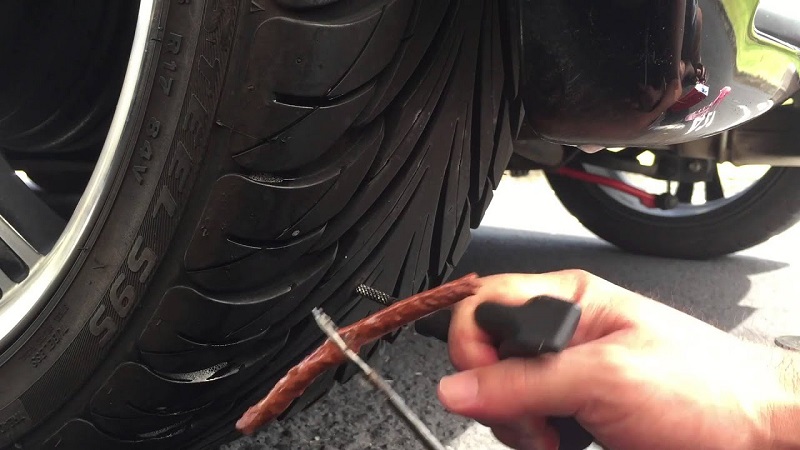So, you have a flat tire or one that’s leaking air. It’s not the end of the world. Luckily there are safe and cost-effective ways to properly repair most tire punctures. The purpose of this article is to show you the difference between a safe, permanent repair and a temporary string, plug or patch repair.
According to the National Highway Traffic Safety Administration (NHSTA) and the Tire Industry Association (TIA), the only method to properly repair a tire puncture is to fill the injury with a repair stem and back the stem with a repair patch. This is commonly known as a combination repair or a patch/plug repair.
Patch/plug repairs are most often performed using a one-piece repair unit that combines the repair stem and cap (or patch) into one unit. However, special circumstances may require the use of a two-piece combination repair (ex. If the angle of the puncture exceeds 35 degrees). The repair is then permanently bonded to the inside of tire and through the injury channel using a cold, chemical vulcanizing process.
The repair essentially becomes part of the tire, creating an air-tight seal that keeps air in and moisture and contaminants out (more on this procedure below).
Emergency roadside plug repairs are NOT intended to be a permanent tire repair. Plugs and string repairs are designed to get you back up and rolling long enough to get home or to the nearest service center to perform a proper tire repair.
The common misconception with plug and string repairs is that because they hold air, they are safe to use. While it is true that many plug repairs do a great job of keeping air in the tire, that’s only part of the equation. Because they’re not completely sealing the injury, plug repairs may allow air and moisture to penetrate the body of the tire. Over time, this could lead to a dangerous (or even deadly) blowout.
A Patch-Only Tire Repair Leaves Your Tire Susceptible to DamageA tire repair that uses only a patch is also NOT considered proper or safe.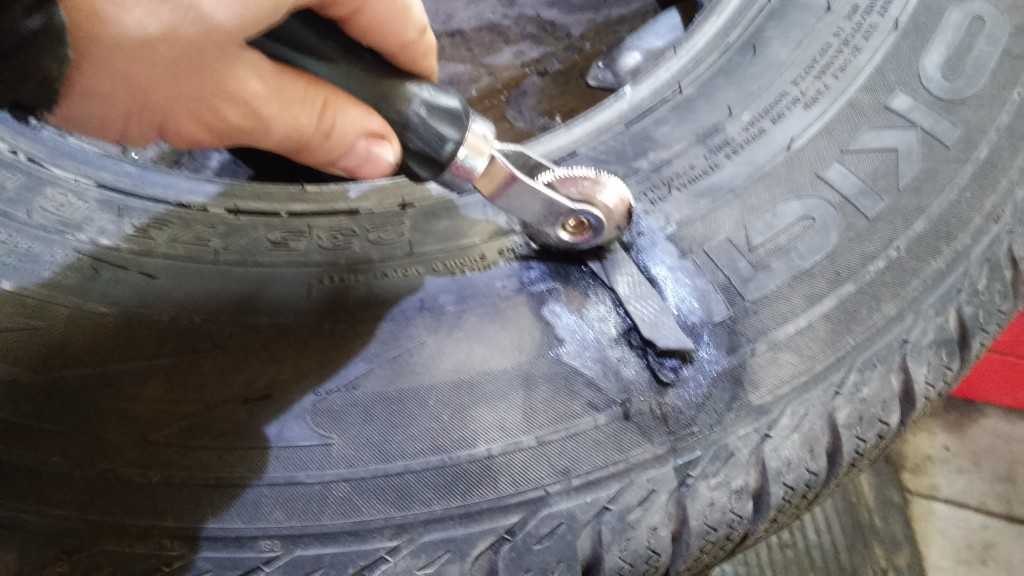 A properly installed patch will do a great job of allowing the tire to hold air. However, similarly to the plug-only repair, the patch does not fill the injury channel. Therefore, air and moisture could seep into the tire from the tread surface and eventually damage the tire.
A properly installed patch will do a great job of allowing the tire to hold air. However, similarly to the plug-only repair, the patch does not fill the injury channel. Therefore, air and moisture could seep into the tire from the tread surface and eventually damage the tire.
Only a proper patch/plug repair completely seals the puncture from inside the tire and through the entire injury channel. There are a few extra steps necessary to perform a proper tire repair in accordance with industry guidelines. We’ve developed a simple acronym to help organize and remember the steps: R.E.P.A.I.R.
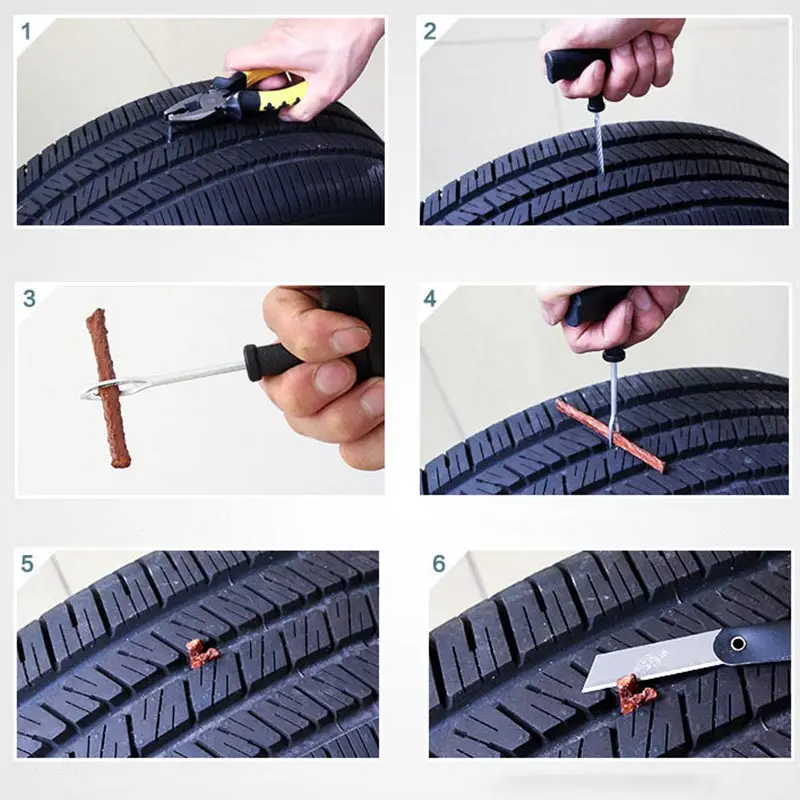 It can also be determined if the puncture did any significant damage to the cords or belts.
It can also be determined if the puncture did any significant damage to the cords or belts.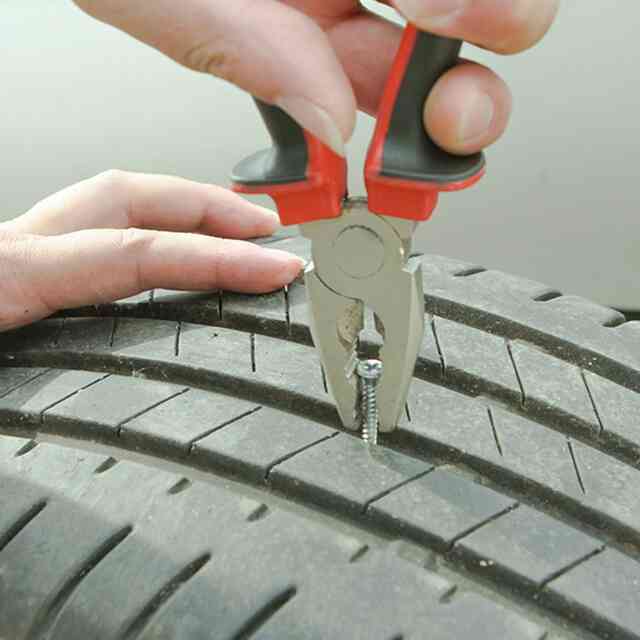 The over-buffed area of the inner liner is treated with a thin layer of rubber sealant, and the excess repair is trimmed to approximately ¼” above the tread surface.
The over-buffed area of the inner liner is treated with a thin layer of rubber sealant, and the excess repair is trimmed to approximately ¼” above the tread surface.There are a number of factors that may determine whether or not your tire is safe to repair. These factors fall into three main categories:
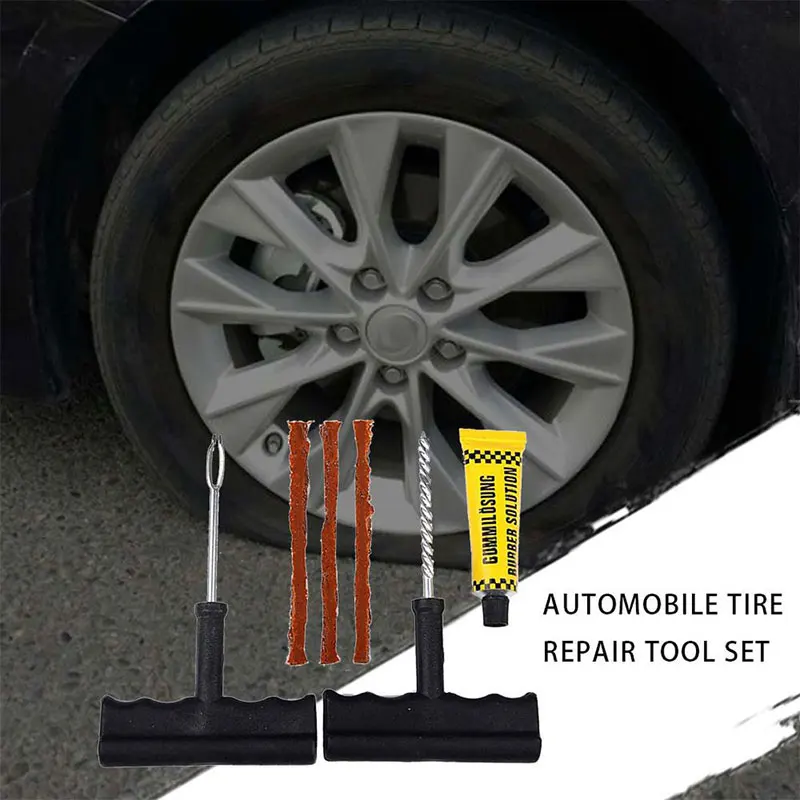 Excessive wear, casing separation, impact damage and other conditions may make it unsafe to properly repair your tire. For a more comprehensive list of repairable vs. non-repairable conditions visit our blog Can Your Tire Be Repaired?
Excessive wear, casing separation, impact damage and other conditions may make it unsafe to properly repair your tire. For a more comprehensive list of repairable vs. non-repairable conditions visit our blog Can Your Tire Be Repaired?The occasional flat or leaky tire is an unavoidable part of life. But, taking shortcuts to repair it can be dangerous to you and your passengers. Take the time and do the research to do the job right and/or find a reputable tire repair shop trained in proper tire repair procedure.
I’ve heard that it’s not very safe to drive on a plugged tire. Is that true? Why is repairing or replacing a damaged tire a better option than plugging a tire? What are the dangers of driving on a plugged tire?
We’ve all been there before. You wake up or walk to your car after work, only to look down and see a flat tire and a nail sticking out.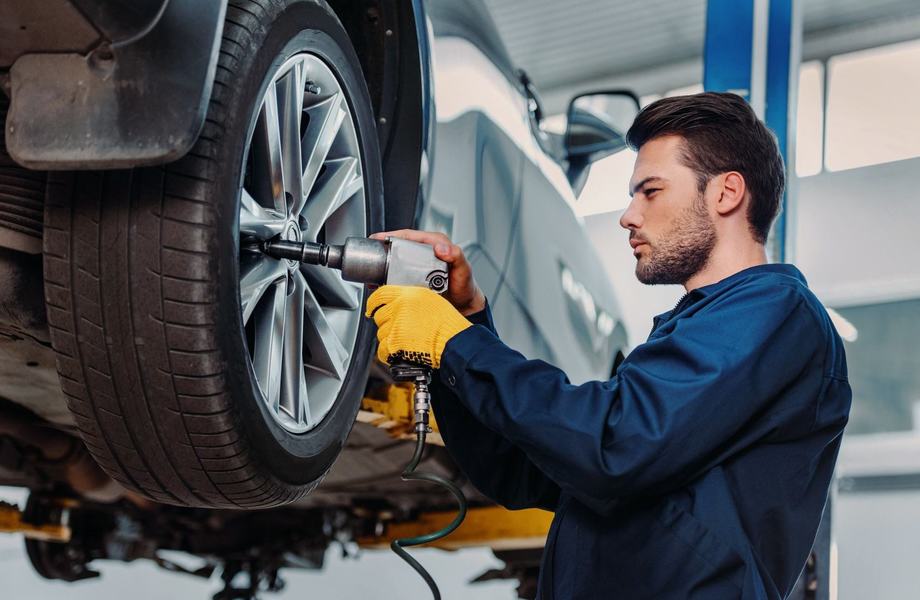 You don’t have time to take your vehicle into an auto shop and need a quick fix. It’s a small nail, so you plug your tire and go on with your life.
You don’t have time to take your vehicle into an auto shop and need a quick fix. It’s a small nail, so you plug your tire and go on with your life.
You only meant for the plug to be a temporary solution until you could get the tire replaced. Then life happens, and it’s a few days before you can get a new tire. Those few days turn into months, which can quickly turn into a year. You may start to ask yourself if it’s really safe to drive on a plugged tire.
It turns out that installing a plug can have a serious impact on the life and integrity of your tire. That is if it’s safe to plug your tire at all. Here is what you need to know about plugged tires and how safe it really is to drive on one.
The first thing you should consider when plugging a tire is if it’s safe to install a plug in the first place. There are specific cases when it’s safe to use a plug. Outside of these scenarios, driving on a plugged tire could be dangerous to you and other drivers.
Depending on the size of the puncture, the extent of the damage, and the tread of your tire, you may not be able to repair the tire with a plug. The size of the hole must be no larger than 0.25 inches and must be located on the tread of your tire. If the puncture is on the shoulder or sidewall, then you will need to replace the tire.
The angle of the puncture also makes a big difference in the effectiveness of a plug. Ideally, the nail or object that punctured your tire went straight in. This would make a repair fairly straightforward. However, if the tire was punctured at an angle, the plug will have a hard time completely sealing the punctured area. Take note of how the nail or screw looks and the angle that it entered the tire.
The age and quality of your tire is also an important factor in whether or not it can be plugged. If the tread on your tire has been worn below 2/32 of an inch, then your tread is too far gone to be plugged. If you’re wondering how you can measure this, 2/32 of an inch is the amount measured by the classic penny test.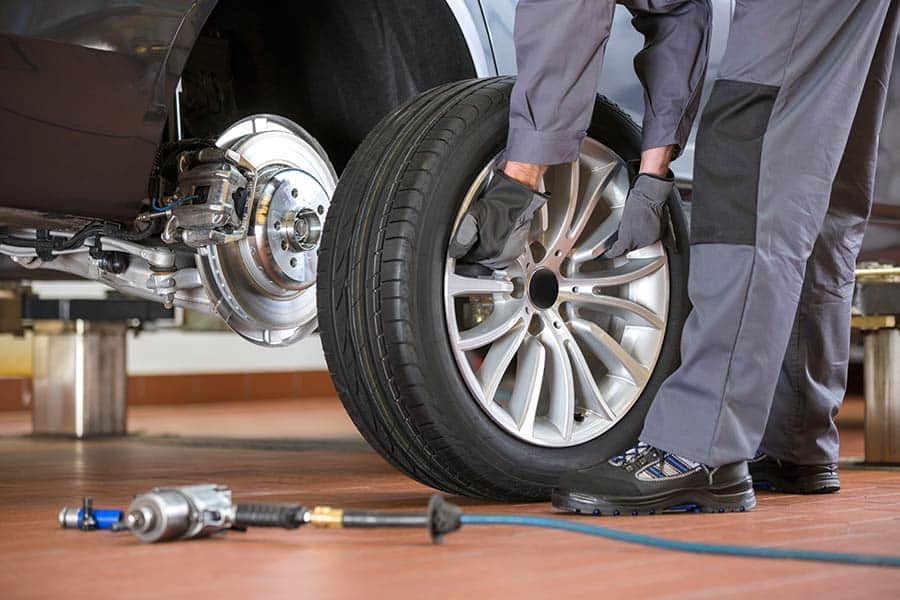 Make sure your tire passes the penny test before you even thinking of plugging it. If it doesn’t pass the test, then it’s probably time for a new set of tires anyway.
Make sure your tire passes the penny test before you even thinking of plugging it. If it doesn’t pass the test, then it’s probably time for a new set of tires anyway.
If you have to ask yourself whether or not your tire can be repaired, that may be a sign that it’s time to move on. A TIA-certified tire technician can inspect your tire and let you know for certain if it’s safe.
Another thing to think about when it comes to driving on a plugged tire is how your repair may impact the manufacturer’s warranty on your tire. Improper repair and maintenance is a surefire way to void your warranty. Think twice the next time you consider opting for a DIY approach on your next tire repair.
When it comes to the safety of your vehicle, it’s always best to leave things to the experts. By having your tire repaired by a certified professional, you can be confident your repair is performed properly, and your manufacturer warranty is still “good.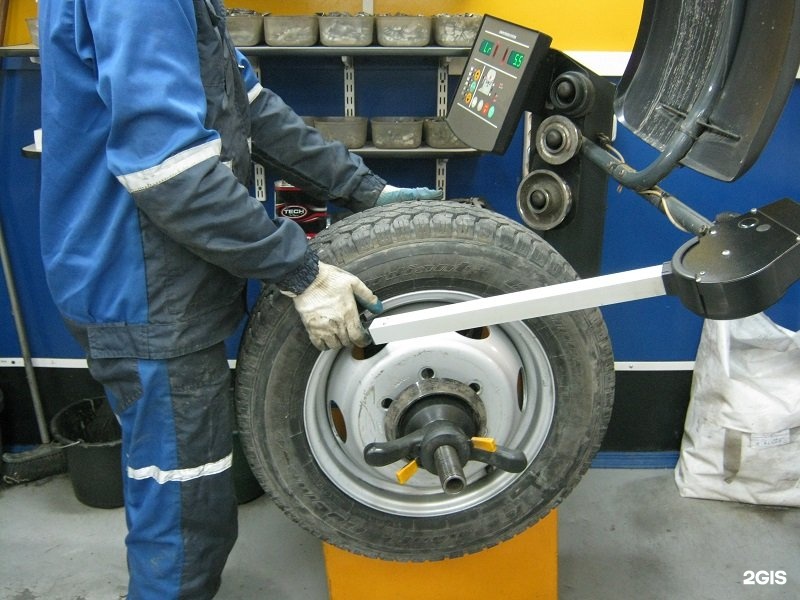 ”
”
The biggest problem with driving on a plugged tire is that you still have a hole in your tire! While it may be a temporary fix, it’s important to recognize that there is still a structural failure in your tire that needs to be addressed.
It only makes sense that a plugged tire cannot handle the same level of stress and strain as a tire in good condition. This is especially true when you start reaching higher speeds on the highway. The manufacturer won’t support a tire’s speed rating once it has been repaired. So, if you plan on racing, off-roading, or just want to go fast, a plugged tire isn’t going to work.
Over time, it’s possible for that small puncture to slowly get larger. This results in a greater loss of air while also increasing your chances of a blowout on a road. Furthermore, the plug itself may fail while you are driving, putting you back where you started.
In the event of a flat tire from a nail or screw, the best course of action is always to replace the tire.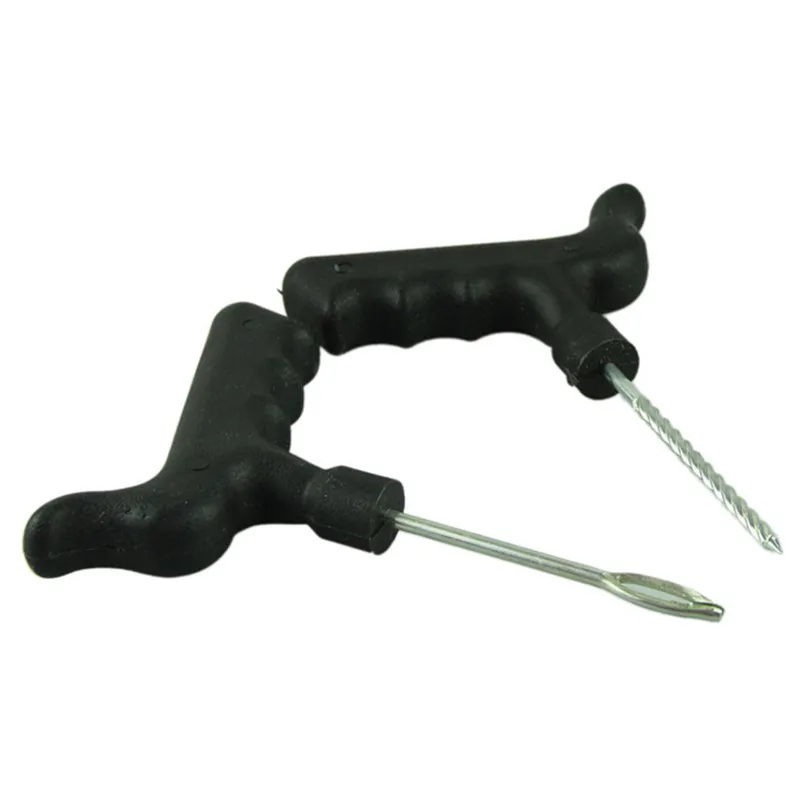 A plug or patch for your tire may help tide you over until you can have it replaced, but it’s important to remember that a plug is meant to be a temporary fix.
A plug or patch for your tire may help tide you over until you can have it replaced, but it’s important to remember that a plug is meant to be a temporary fix.
While it may be tempting to see how far you can get with a five-dollar repair, the consequences of a plugged tire failing will be much worse than if you had replaced the tire in the first place.
If you just purchased a tire or recently bought a set of expensive tires, it can be a frustrating experience. If this is the case and you hope the tire can be saved, it may be worth it to have it inspected by a professional.
The TIA-certified tire experts at Tread Connection know how to properly diagnose, inspect, and repair flat tires. When you work with Tread Connection for your flat repair, the tire will be removed from the wheel and carefully inspected inside and out. This helps us ensure whether or not it can be safely repaired.
If the tire can be repaired, our team will take care of it for you. In the event that your tire cannot be safely repaired, our team will recommend a replacement from our wide range of tires to find the right one for your needs, and your budget.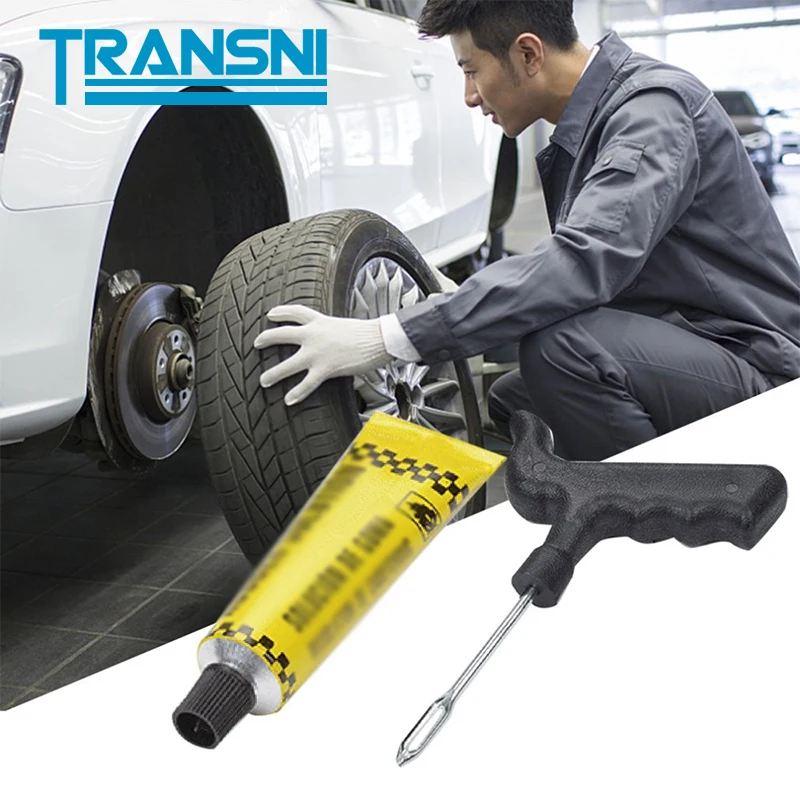
It’s never worth it to gamble when it comes to the safety of you and your vehicle. Don’t try to see how long you can drive on that plugged tire. Have your tire inspected and repaired the right way by the TIA-certified tire experts at Tread Connection.
We bring the tire shop to you and can repair your flat or replace your tire at your home and on your schedule. Schedule your tire service with Tread Connection today!
BUY TIRES
The number of workshops specializing in tire fitting is growing every day. But on the way, both a motorist and other vehicles can have a very unpleasant situation: a wheel has broken through, and the nearest car service is far away. And if the car often has a "spare wheel", then what should a cyclist or a motorcyclist do? So there is a need to repair the camera or the wheel itself right on the road.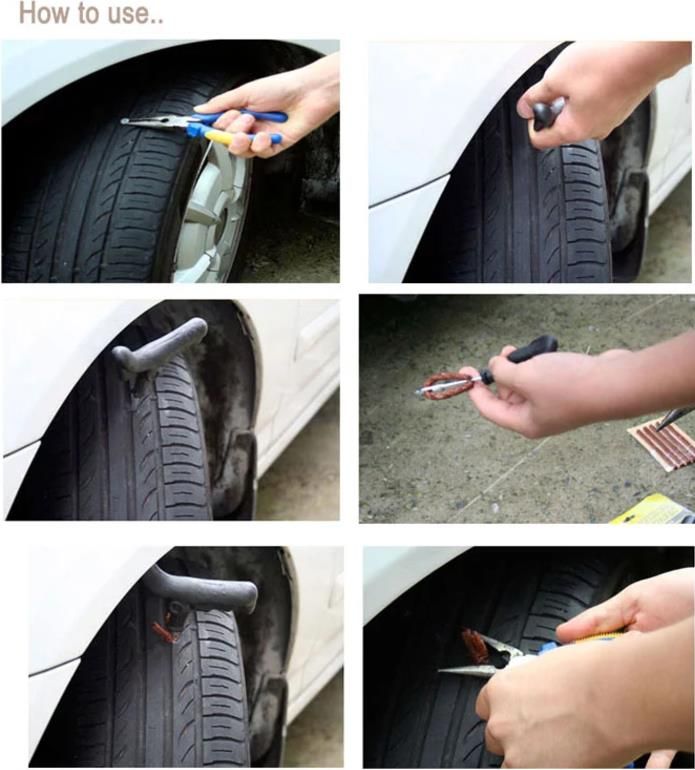
When we use this term, we are talking about a very complex and somewhat unique process. During this action, the crude rubber is transformed into rubber. This leads to a significant improvement in the quality of the material. Rubber is used here in order to eliminate the punctures formed in the chambers. There are different variants (methods) of vulcanization.
There are two main types of vulcanization - hot and cold. Electric vulcanization refers to hot. What can be used as a heater? An electric stove is often used, but a hair dryer and an iron may well be suitable. For this method, the optimum temperature is 145 degrees Celsius. To determine whether the temperature is appropriate, other means at hand are quite suitable. You can even take a sheet of paper. If it begins to char, the temperature is already quite suitable.
You can also think of special clamps with heating elements.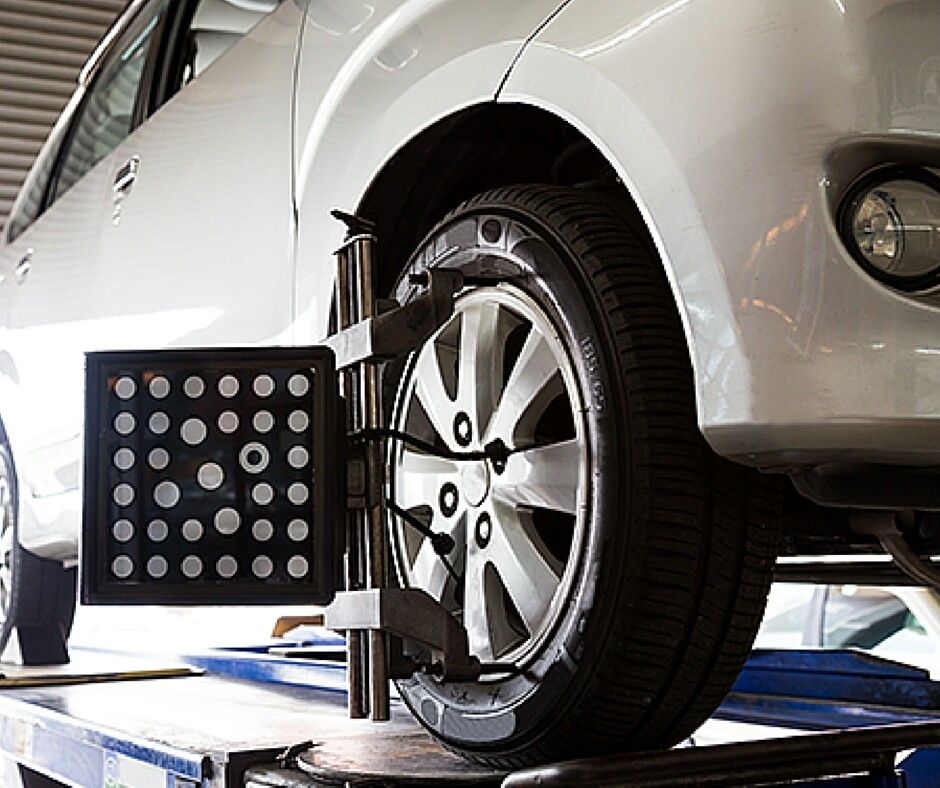 They work from a regular 220 volt outlet. You can use a car battery or your own battery. Such auxiliary elements are simple and easy to use. To do this, a rubber patch is applied to the camera, clamped and then plugged into the network.
They work from a regular 220 volt outlet. You can use a car battery or your own battery. Such auxiliary elements are simple and easy to use. To do this, a rubber patch is applied to the camera, clamped and then plugged into the network.
In this process, a chemical reaction takes place in the tire, during which the sulfur atoms are attached to the rubber. By adding up to 5 percent, you can get excellent raw materials from which cameras and tires are made. When gluing sulfur and rubber, a so-called bridge is formed. A similar procedure refers to the hot method. However, it is extremely difficult to do this during a trip on the highway or on a hike.
As a raw material, rubber has an interesting property: it turns into a single mass at a certain sufficiently high temperature. As a result, the rubber will become rubber and its return to its previous state is absolutely impossible. This ability of rubber allows you to cope with both punctures and cuts.
Hot tire repair is only possible with a press. Welding time is proportional to the depth and area of the cut. So, it will take about 4 minutes to restore one millimeter of a cut. The equipment must be properly warmed up and adjusted.
When performing hot vulcanization, it is important to control the temperature. It should stay around 150 degrees Celsius. If the temperature is higher, the rubber will simply deteriorate and lose all its properties.
Now there is no difficulty in using this method, because you can buy a kit that allows you to carry out repairs at any point of sale of automotive goods.
Repair is done in a way reminiscent of hot. It is also necessary to treat the surface with abrasive material, remove dust and degrease. Once dry, attach the patch using the included adhesive specially designed for this purpose.
This process is simple, you can do it yourself anywhere. But raw rubber cannot be made at home. It is necessary to go to a place where there is special equipment for the corresponding manipulations.
It is necessary to go to a place where there is special equipment for the corresponding manipulations.
The main advantage of this process is the fact that the repair will cost much less than buying a new one. But each situation must be considered individually, and, based on all the circumstances, to determine whether it makes sense to repair.
The cold method is affordable and takes little time at a minimum cost. But its main disadvantage is the low degree of reliability of gluing car tires . This procedure is temporary, it is better to immediately contact the service station.
Tire repair by the "hot" method is carried out at specialized stations. With its help, rubber is reliably welded, and the price of such work is quite low.
What conclusion can be drawn from this? Vulcanization improves the quality and service life of the tire, it can be carried out by various methods, but it is still better to entrust this work to professionals, since in this case we are talking about safety.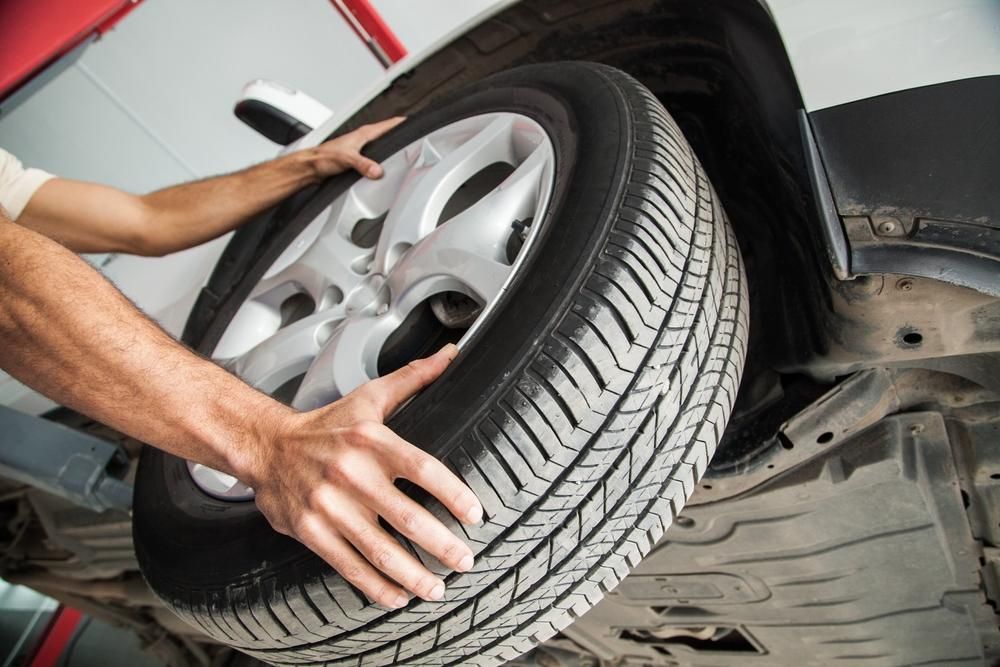
| What is the XL marking on a tire? XL (Extra Load) - marking on the tire, which literally means "extra load". This indicates that the tire is designed for more weight than standard rubber.. February 23, 2023, 15:32 | |
| What winter tires to buy? Expensive or cheap? To begin with, it is worth knowing the division into classes of car tires. It is useful to know when to buy expensive premium tires and when to choose cheaper analogues from the economy segment... 06 September 2022, 10:06 | |
| Tires for electric vehicles - which ones to choose? Driving an electric car is different from driving a car with an internal combustion engine. This is felt by both the driver and passengers. 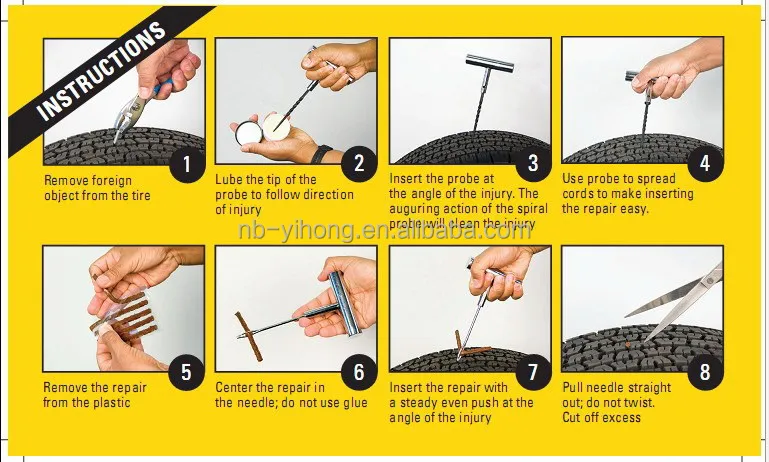 For tires, another type of drive is also important. Rubber on.. For tires, another type of drive is also important. Rubber on.. August 09, 2022, 11:58 | |
| Who are low profile tires suitable for? Car wheels are the first thing that comes to mind in the context of visual tuning. Not every car will be better after installing a tailgate spoiler. And big.. 18 April 2022, 15:42 | |
| What are UHP (HP) tires? Best choice for summer High Performance and Ultra High Performance tires are becoming increasingly popular all over the world. Our cars are getting faster, more efficient, accelerate better and provide more confidence.. February 28, 2022, 15:06 | |
Trouble with the wheel can happen at any time and to anyone. Now we will tell you what to do in this case and how to understand that the wheel is broken or dangerous to use.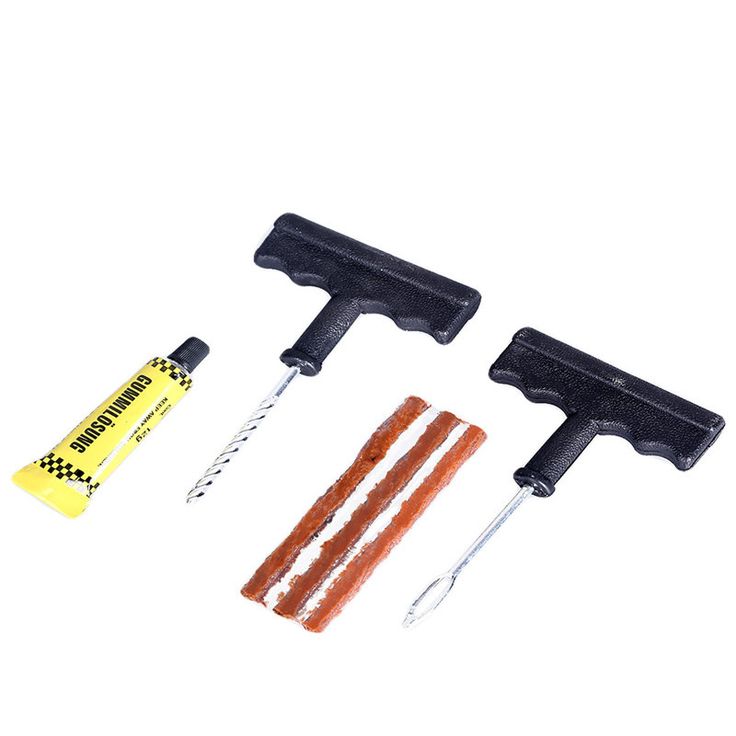 When repair is suitable, and when the tire is only subject to replacement.
When repair is suitable, and when the tire is only subject to replacement.
In addition to the banal nail sticking out of the wheel, there are indirect signs of tire deformation:
while driving, the car leads to one side;
ride stiffness increased;
became worse handling and maneuverability;
extraneous sounds appeared in the car, similar to champing;
other drivers on the road honk and draw attention.
Outwardly, tire failure may look like swelling or a foreign object can be seen. Sometimes the foreign object is not visible, but the tire is flat or the cut is visible.
In any of these situations, it is no longer possible to drive the car further, but it is necessary to repair the tires.
The most common cause of tire failure is poor road quality or improper vehicle operation.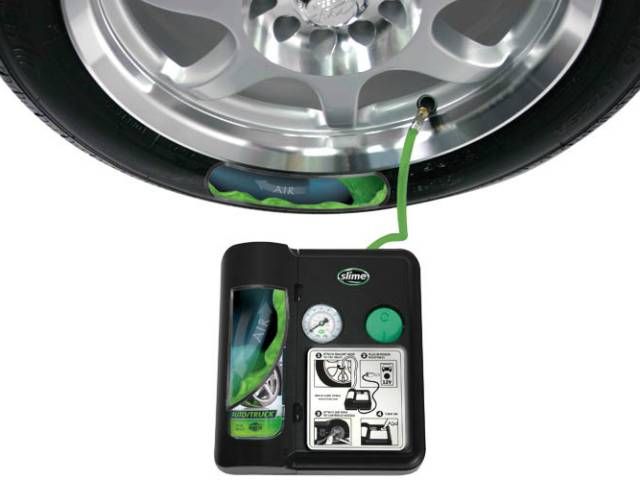 Another reason is tire tread wear. The transverse protrusion at the bottom of the tread groove is the tire wear indicator, do not ignore the tread indicator.
Another reason is tire tread wear. The transverse protrusion at the bottom of the tread groove is the tire wear indicator, do not ignore the tread indicator.
By the way, if you were driving technically correctly and hit a deep pothole, then the responsibility for this lies with the road service. You can call the traffic police and draw up a protocol, take the case to court.
There are several types of tire failure, let's look at the differences.
The most harmless option. But the use of such rubber is strictly prohibited. This is fraught with deformation of the sidewall, the tire overheats, delaminates, the cords break, and the wheel frame becomes unusable. So the harmlessness ends with the beginning of the trip. Definitely need repair, independent or in the tire center.
When a tire is punctured, the cord may or may not be damaged. When removing the culprit of the deformation, inspect the puncture site well. The edges are even and close well - the cord is not damaged. Then tire repair can be done without removing the wheel.
The edges are even and close well - the cord is not damaged. Then tire repair can be done without removing the wheel.
What to do to repair:
Further actions depend on the repair kit that you use.
If it is a sealant, it must be poured through the nipple, turn the wheel with the deformation down and wait for sealing.
If you have a tourniquet or insert, then the edges of the hole need to be sanded, treated with a special compound, and with the help of an awl, plug the puncture with a tourniquet. Then pull out and cut flush with the rubber surface.
If the cord is damaged:
But the repair does not end there, further balancing of the wheel will be needed. But the price for this service is still lower than the cost of a new tire.
Moisture and air enter the cord through cracks. The tire is failing. In this case, tire repair is not possible, only replacement.
Due to the cut, the integrity of the frame is violated and it will no longer be possible to restore it, the repair will not save. In addition, this most often occurs on the road, and after a cut, the tire has time to make a few more revolutions, which leads to even more damage.
Repairing side cuts is the most difficult of all. A longitudinal incision can only be repaired if it does not exceed 35 mm. And the transverse should be no more than 25 mm. This is due to the extent of the violation of the integrity of the threads. But even with a slight deformation, we do not recommend repairing side cuts. It is better and safer to change the tire. Even the best side cut repair does not guarantee that an obstacle or contact with a bump in the road at high speed will not lead to tire blowout and loss of control. This is too high a price to pay.
The cord breaks or the frame exfoliates. As a result, a hernia appears. This happens due to impact, collision with an obstacle, factory defects. As with a fissure, a hernia cannot be repaired. Another danger is that the hernia can explode at any moment. So you need to drive very carefully to the nearest service station, and it is better to rearrange the damaged wheel back.
This happens due to impact, collision with an obstacle, factory defects. As with a fissure, a hernia cannot be repaired. Another danger is that the hernia can explode at any moment. So you need to drive very carefully to the nearest service station, and it is better to rearrange the damaged wheel back.
There is an option to put a reinforced patch on the hernia, but it does not guarantee safety on the road. Such repairs can be considered only to reach the destination.
Whatever damage to the wheel may overtake you on the road, we do not recommend trying to repair it yourself, especially without special skills. Repair of hernias, punctures, cuts and even side cuts of tires is available in the network of service centers of the Wheel for Free, and if it is not possible to repair or it will not be practical, the masters will offer to replace the tire.
There is no perfect way and guarantee to permanently avoid tire damage.